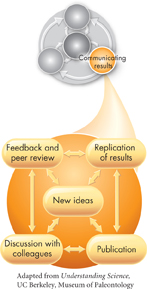Communicating Results: Reviewing and Sharing Ideas
 Why is peer review important?
Why is peer review important?
Data collection and analysis can be a long process. Scientists may focus intensely on a single study for months or even years. Then, the exciting time comes when researchers communicate their experiments and observations to the scientific community. Communication and sharing of ideas are vital to modern science.
Peer Review Scientists share their findings with the scientific community by publishing articles that have undergone peer review. In peer review, scientific papers are reviewed by anonymous, independent experts.  Publishing peer-reviewed articles in scientific journals allows researchers to share ideas and to test and evaluate each other's work. Scientific articles are like high-powered versions of your high school lab reports. They contain details about experimental conditions, controls, data, analysis, and conclusions. Reviewers read them looking for oversights, unfair influences, fraud, or mistakes in techniques or reasoning. They provide expert assessment of the work to ensure that the highest standards of quality are met. Peer review does not guarantee that a piece of work is correct, but it does certify that the work meets standards set by the scientific community.
Publishing peer-reviewed articles in scientific journals allows researchers to share ideas and to test and evaluate each other's work. Scientific articles are like high-powered versions of your high school lab reports. They contain details about experimental conditions, controls, data, analysis, and conclusions. Reviewers read them looking for oversights, unfair influences, fraud, or mistakes in techniques or reasoning. They provide expert assessment of the work to ensure that the highest standards of quality are met. Peer review does not guarantee that a piece of work is correct, but it does certify that the work meets standards set by the scientific community.
Sharing Knowledge and New Ideas Once research has been published, it enters the dynamic marketplace of scientific ideas, as shown in Figure 1–8. How do new findings fit into existing scientific understanding? Perhaps they spark new questions. For example, the finding that growth of salt marsh grasses is limited by available nitrogen suggests other hypotheses: Is the growth of other plants in the same habitat also limited by nitrogen? What about the growth of different plants in similar environments, such as the mangrove swamp shown in Figure 1–9? Each of these logical and important questions leads to new hypotheses that must be independently confirmed by controlled experiments.

FIGURE 1–8 Communicating Results Communication is an important part of science. Scientists review and evaluate one another's work to ensure accuracy. Results from one study may lead to new ideas and further studies.
d
FIGURE 1–9 Mangrove Swamp In tropical areas, mangrove swamps serve as the ecological equivalents of temperate salt marshes. The results of the salt marsh experiment suggest that nitrogen might be a limiting nutrient for mangroves and other plants in these similar habitats.
Design an Experiment How would you test this hypothesis?
 In Your Notebook Predict what might happen if an article is published without undergoing peer review.
In Your Notebook Predict what might happen if an article is published without undergoing peer review.
Table of Contents
- Formulas and Equations
- Applying Formulas and Equations
- Mean, Median, and Mode
- Estimation
- Using Measurements in Calculations
- Effects of Measurement Errors
- Accuracy
- Precision
- Comparing Accuracy and Precision
- Significant Figures
- Calculating With Significant Figures
- Scientific Notation
- Calculating With Scientific Notation
- Dimensional Analysis
- Applying Dimensional Analysis




